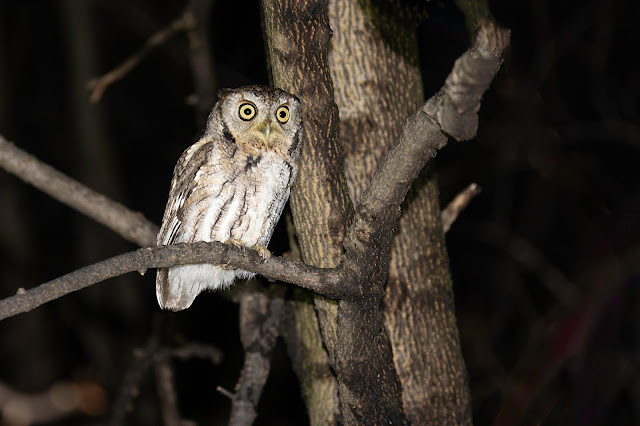Even though I had luck calling in five owls on Wednesday's Rockwood CBC I was a bit frustrated that I couldn't get any photos. My attempt at high-ISO and a flashlight was poor at best, and found that I...
Even though I had luck calling in five owls on Wednesday's Rockwood CBC I was a bit frustrated that I couldn't get any photos. My attempt at high-ISO and a flashlight was poor at best, and found that I couldn't autofocus w/ the Sony 600 mm f/4 GM OSS lens in the dark. Last evening I decided to pull out the Godox V860II Flash and have a play on the Sony a1 and 200-600 mm f/5.6-6.3 G OSS lens + 1.4TCII. The idea being that the zoom lens tends to AF better at low magnifications under extreme low-light conditions. The lower focal length would also make it easier to find the owls in the dark.
When I attempted to use the flash in the house I was UNABLE to control the flash exposure, even though it was on TTL and Auto-ISO on the camera. Everything was washed out no matter how I adjusted the flash settings (it was on Master/Green screen). However, when I tried to operate the flash in the Slave/Orange screen setting I suddenly found myself getting correct exposures and 30 fps strobe as long as I kept the lens at 200-400 mm; if I zoomed to 600mm then I got only a single flash at correct exposure. Attaching a pair of small maglights to the lens and wearing a headlamp I found that AF was fast and accurate even in the darkest corners of the house. It was time to test it out on owls.
This morning I walked out back of the house into the field where our resident Eastern Screech Owl(s) is(are) using the nesting box. With the headlamp on motion detection (I can turn it on/off w/ a wave of my hand next to my head) I stood in the dark and listened for the owl(s) to respond to playback. After a few minutes of silence I saw a shadow fly in and land in the trees to my left. I was able to see its silhouette against the cloudy skies, turn on the headlamp with a wave of my hand next to my right ear, see the owl by its eye-shine, turn on the lens-mounted maglights, and raise the camera and focus on the tiny Screech Owl. AF was fast and accurate as the owl was illuminated by the three light sources, and a burst of the camera gave me 30 fps strobes that perfectly exposed the subject! Flash sync appeared to be 1/60 sec. at ISO 6400.
I'm looking forward to using it again January 1 when I join Allen Chartier and Company for the Detroit River Christmas Bird Count on Belle Isle!
Camera settings (Sony Alpha a1): AF-C, Continuous-High+ (30 fps), Aperture-Priority, f/2.8, ISO 6400, 0.0 Exp. Comp., Spot Focus (Center) - using Recall Custom Hold 1 (AEL button on back of camera). All exposures were 1/60 sec. w/ flash at ISO 6400. Go into Menu System and change to Mechanical Shutter, Flash on "Fill-Flash".
I played more with settings this evening and found that the camera works well at ISO 3200 and wide-area focus or Zone-Focus. If I lower the ISO below 3200 then the camera tends to start missing frames as the flash is using more power per image. Exp. Comp. = -1.0.
Flash: SLAVE (Orange screen), Flash, Manual, Zoom=24mm, CH1, SLAVE, [A], RMT 1
Image adjustments: Red-eye removal was performed by selecting iris + white spot, Desaturating in Photoshop, then selecting iris - white spot and moving Exposure left until gray iris is black. Use Blur tool on edge of iris and white spot to soften / blend w/ rest of eye, I do have the Godox XT1 Remote Commander and an off-camera bracket that I hope to test out to see if I can use the flash w/o generating Red-Eye! Stay tuned...
















